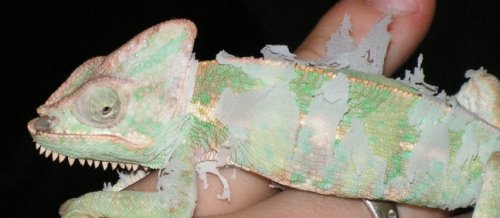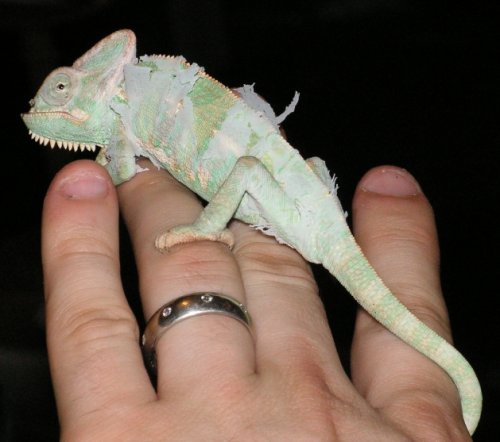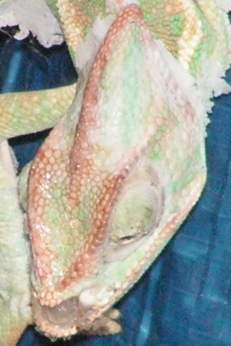2by2
New Member
Hey guys.
Meet Predator. An 8 month old veiled chameleon born and bred by myself......
Predator was a perfect little 4 day old veiled chameleon from a very nice bloodline until he met the cats. As these guys were being born, I had just bought a new house. The door to the cham room didn't close right at the time. So the cats got into the room and decided they needed to chow down on some baby chams. They ended up eating 4 of my hatchling nosy be's, and 2 baby veileds. When I got home from work and found out what happened.....I nearly had cat soup for dinner.....then the wife calmed me down. lol. Anyway, I found predator laying on the floor twitching in the living room.......the living room is on a different floor. He was missing a good bit of his top jaw and his back legs looked to be completely skinless. I had him pinned for dead. He was so done, I'm not even sure why I tried. But I warmed him up, and he started moving around a little bit. Even with all his new problems, he wouldn't give up. He ate and drank all by himself the whole time. After about 2 weeks you couldn't even tell that he had any leg injuries, and his face had all but healed over. To this day he's still alive a kicking. As you can probably tell from the pics, he's only about the size of a normal 3 month old veiled or so. I'm not sure why he's had so much trouble growing....but I'm assuming it had something to do with the trauma as a baby.
The reason I'm posting this is because I just took some pics and I wanted to show off my little monster. lol. And also.....to help warn other people that cats and chams dont mix. Do anything and everything in your power to keep them away from each other.....or this is what could happen.
Meet Predator. An 8 month old veiled chameleon born and bred by myself......
Predator was a perfect little 4 day old veiled chameleon from a very nice bloodline until he met the cats. As these guys were being born, I had just bought a new house. The door to the cham room didn't close right at the time. So the cats got into the room and decided they needed to chow down on some baby chams. They ended up eating 4 of my hatchling nosy be's, and 2 baby veileds. When I got home from work and found out what happened.....I nearly had cat soup for dinner.....then the wife calmed me down. lol. Anyway, I found predator laying on the floor twitching in the living room.......the living room is on a different floor. He was missing a good bit of his top jaw and his back legs looked to be completely skinless. I had him pinned for dead. He was so done, I'm not even sure why I tried. But I warmed him up, and he started moving around a little bit. Even with all his new problems, he wouldn't give up. He ate and drank all by himself the whole time. After about 2 weeks you couldn't even tell that he had any leg injuries, and his face had all but healed over. To this day he's still alive a kicking. As you can probably tell from the pics, he's only about the size of a normal 3 month old veiled or so. I'm not sure why he's had so much trouble growing....but I'm assuming it had something to do with the trauma as a baby.
The reason I'm posting this is because I just took some pics and I wanted to show off my little monster. lol. And also.....to help warn other people that cats and chams dont mix. Do anything and everything in your power to keep them away from each other.....or this is what could happen.








